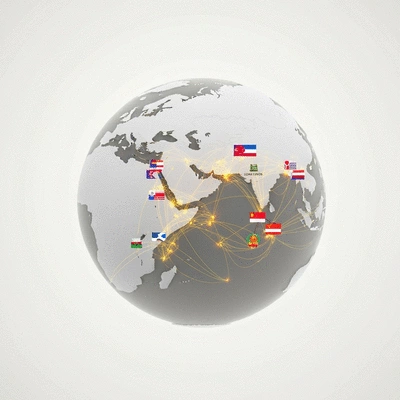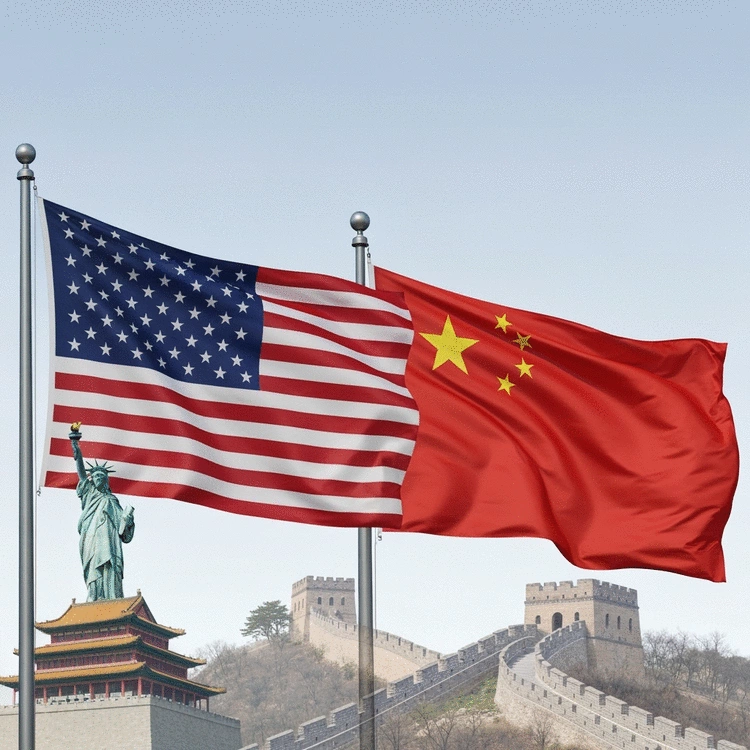As we navigate the intricate web of U.S.-China relations, consider this: the dynamics at play not only impact the two nations involved but also send ripples across the globe. How can we better understand this complex relationship and its implications for international affairs?
What You Will Learn
- The historical milestones that have shaped U.S.-China relations, from diplomatic ties to trade agreements.
- How trade tensions and tariffs are affecting global economies, leading to shifts in consumer prices and supply chains.
- The role of technological competition as a new battleground, particularly in areas like AI and cybersecurity.
- Key geopolitical tensions and their implications for international politics and regional security.
- Strategic recommendations for navigating U.S.-China relations, emphasizing the importance of diplomacy and multilateralism.
Key Dynamics in U.S.-China Relations
The relationship between the U.S. and China is shaped by evolving trade policies, geopolitical tensions, and technological competition. Global conflicts shaping tomorrow's affairs often have their roots in such complex bilateral dynamics.
Trade & Economic Interdependence
Trade has historically been the backbone, now marked by tariffs and discussions of decoupling. Key historical events:
- 1979: Diplomatic Relations
- 2001: China joins WTO
- 2018: Trade Tensions Begin
Geopolitical Competition
Beyond economics, both nations vie for global influence and security. Focus areas include:
- Military Posturing
- Diplomatic Efforts
- South China Sea Dispute
Technological Supremacy
Technology is a new battleground, shaping economic and strategic power. Key areas:
- AI & 5G Dominance
- Emerging Technologies
- Cybersecurity Concerns
Future Outlook & Diplomacy
Projections indicate a new phase with evolving policies and strategies, including:
- Increased Diplomatic Dialogues
- Trade Policy Reforms
- Collaborative Initiatives (e.g., climate change)
The Interplay of U.S.-China Relations and Global Dynamics
When we look at the intricate dance between the U.S. and China, it's clear that their relationship doesn't just affect them but reverberates across the globe. Understanding this dynamic is essential for grasping the larger picture of international relations today. As a platform at The Stone Builders Rejected, we're committed to unraveling these complex threads and providing you with insights that matter.
From trade disputes to geopolitical maneuvering, the multifaceted nature of U.S.-China relations influences everything from global markets to international security. So, let’s delve into the current landscape of these relations and the factors that shape them!
Understanding the Current Landscape of U.S.-China Relations
To truly understand the present, we need to revisit the past. The history between the U.S. and China is packed with pivotal moments that have set the stage for the current landscape. Here’s a brief overview:
- 1979: The establishment of diplomatic relations marked a significant shift.
- 2001: China's entry into the World Trade Organization (WTO) opened up new avenues for trade.
- 2018: The initiation of trade tensions brought tariffs into the spotlight.
These events highlight the evolution of their interactions, which have transitioned from cooperation to competition, especially in trade and technology.
Key Historical Context: A Brief Overview of U.S.-China Relations
The journey of U.S.-China relations is fascinating! Initially characterized by a hopeful partnership aimed at mutual growth, the relationship began shifting in the early 21st century. The rise of China as an economic powerhouse coincided with growing concerns in the U.S. about trade imbalances and intellectual property theft. This period laid the groundwork for the tensions we see today.

As we examine this history, it’s essential to acknowledge how these early decisions influence current policies and perceptions. The resilience of this relationship rests on the ability of both nations to adapt and respond to changing global dynamics.
The Evolution of Trade Relations and Economic Partnerships
Trade is often seen as the backbone of U.S.-China relations. Over the years, they've forged economic partnerships that have significantly impacted global trade routes and practices. Here are some key developments:
- The establishment of trade agreements aimed at reducing tariffs and enhancing cooperation.
- Increased investments from both nations in technology and infrastructure.
- Shifts in manufacturing practices due to rising labor costs in China.
These changes reflect how intertwined our economies have become, but they also spotlight the vulnerabilities that arise from such deep interdependence.
The Influence of Bilateral Relations on Global Governance
The effects of U.S.-China relations extend beyond economics into realms like global governance. The two countries hold significant sway over international organizations, shaping policies that affect nations worldwide.
For instance, their collaboration—or lack thereof—on issues such as climate change and security can dictate the global response. The need for effective diplomacy is essential, as it can pave the way for solutions to pressing global challenges. To stay competitive, many nations are also exploring new technologies, such as those discussed in AI Technologies to Watch in 2025.
Impact of Trade Tensions on the Global Economy
Trade tensions have become a defining feature of U.S.-China relations, with broad implications for the global economy. We must analyze how these tensions manifest and the ripple effects they create.
Let’s break down some key aspects of this impact:
- Increased tariffs leading to higher consumer prices.
- Supply chain disruptions affecting businesses and economies worldwide.
- Shifts in investment patterns as companies reconsider their strategies.
These points illustrate just how interconnected our global economy is, and any significant change in U.S.-China relations sends shockwaves through various sectors.
Analyzing Tariffs and Their Effects on Trade Dynamics
Tariffs have become a tool of choice in this ongoing trade war. They are not just numbers on a spreadsheet; they have real consequences for businesses and consumers alike. By increasing costs, tariffs can lead to a chain reaction that impacts everything from manufacturing to retail.
For example, many companies have started sourcing materials from different countries to avoid tariffs, which disrupts established supply chains and leads to inefficiencies.
The Role of Economic Decoupling in Shaping Global Markets
Evolving trade policies have prompted discussions around economic decoupling—the idea that the U.S. and China may begin to separate their economies. This shift could reshape how businesses operate globally, creating new alliances and potentially leading to increased protectionism.
It’s essential to closely monitor these developments, as they could influence market dynamics for years to come!
Understanding Trade Agreements and Their Impact on U.S.-China Trade Relations
Trade agreements play a crucial role in defining how countries interact economically. The U.S. and China have entered a series of agreements aimed at addressing trade deficits, intellectual property rights, and market access.
Each new agreement—or the unraveling of existing ones—can significantly alter the landscape, affecting not just bilateral relations but the global economy at large.
Geopolitical Tensions and Their Influence on International Politics
The geopolitical chess game between the U.S. and China is not just about trade; it's also about power and influence on the global stage. Let’s explore how these tensions shape international politics.
Some key points to consider include:
- Military posturing and its effect on regional security.
- The role of diplomacy in easing conflicts.
- Key areas of contention, such as the South China Sea dispute.
Understanding these elements helps us appreciate the broader implications of U.S.-China relations beyond mere economics.
Military Posturing and Its Implications for Global Security
The military dynamics between the U.S. and China can lead to increased tensions, particularly in strategic regions. As both nations enhance their military capabilities, it raises concerns about stability and peace.
This military buildup is more than just a show of strength; it can lead to miscalculations that result in conflict. Thus, effective communication and diplomacy are vital!
The Role of Diplomacy in Mitigating U.S.-China Conflicts
Diplomatic efforts aim to prevent tensions from escalating into open conflicts. Engaging in dialogue is crucial for navigating the complex issues at play.
Through negotiations and collaborative efforts, both nations can work towards finding common ground and fostering peace in the region.
The South China Sea Dispute: Navigating Regional Stability
The South China Sea is a particularly contentious area, with multiple nations claiming portions of its waters. The U.S. has taken a stance to protect navigation rights, which puts it at odds with China’s territorial claims.
This dispute exemplifies the challenges that arise from competing interests and the need for careful diplomacy to ensure regional stability.
Technological Innovation: A New Battleground
In today’s world, technology has emerged as a new battleground in U.S.-China relations. The competition for technological supremacy is reshaping economic strategies and international alliances.
Key aspects to consider include:
- The competitive edge that tech advancements provide.
- Emerging technologies and their broad economic implications.
- Cybersecurity concerns that stem from fast-evolving tech.
As these technologies evolve, they bring not just opportunities but also new challenges that both nations must navigate carefully.
The Competitive Edge: How Tech Advancements are Shaping Relations
Tech advancements are more than just innovations; they represent power. The race for dominance in areas like artificial intelligence and 5G technology has significant implications for national security and economic competitiveness.
Both countries are investing heavily in research and development, making this a critical area to watch!
Emerging Technologies and Their Economic Implications
New technologies can disrupt industries, reshape economies, and redefine global power structures. Innovations in areas such as renewable energy, biotechnology, and advanced manufacturing are critical to future economic landscapes.
As we explore these emerging technologies, we must consider their broader implications for U.S.-China relations and global markets.
Cybersecurity Concerns in U.S.-China Relations
As technology advances, so do cybersecurity threats. The tension between the U.S. and China has led to increased concerns about data security, espionage, and the protection of intellectual property.
Addressing these cybersecurity issues is essential for fostering trust and cooperation in the tech space.
Case Studies: Industries Affected by U.S.-China Trade Relations
To ground our exploration in reality, let’s examine specific industries that illustrate the impact of U.S.-China trade relations. Here are a few sectors significantly affected:
- Technology: Companies facing tariffs and supply chain disruptions.
- Manufacturing: Shifts in production locations due to rising costs.
- Agriculture: Changes in export markets and tariffs affecting farmers.
These case studies provide a window into how policies shape real-world economic outcomes, highlighting the tangible effects of U.S.-China relations.
Examine the Impact on Key Sectors like Technology and Manufacturing
In the technology sector, companies are re-evaluating their supply chains and market strategies in response to tariffs and restrictions. The manufacturing sector faces similar challenges as companies adapt to shifting regulations and seek more stable environments.
The ripple effects of these shifts are felt across the globe, influencing everything from pricing to innovation.

Insights from Supply Chain Disruptions and Adaptations
Supply chain disruptions during the trade tensions have forced companies to rethink their sourcing strategies. This has led to a diversification of suppliers and an increased focus on resilience in supply chains.
Understanding these adaptations sheds light on how businesses are strategizing in an uncertain environment.
The Role of Global Supply Chains in U.S.-China Economic Interactions
Global supply chains are a testament to how interconnected our economies have become. U.S.-China trade relations significantly influence these networks, affecting how goods are produced and distributed worldwide.
As we analyze these dynamics, it’s crucial to consider how shifts in trade policies might reshape the future landscape of global supply chains, impacting us all.
Did You Know?
A recent study revealed that approximately 70% of global trade flows are influenced by U.S.-China relations. This staggering statistic underscores the critical importance of understanding the complexities of their interactions, as any significant changes can ripple through economies worldwide.
Frequently Asked Questions (FAQs) about U.S.-China Relations
- What are the primary factors shaping U.S.-China relations?
- U.S.-China relations are primarily shaped by evolving trade policies, geopolitical tensions, and intense technological competition, especially in areas like AI and 5G.
- How have trade tensions impacted the global economy?
- Trade tensions have led to increased tariffs, causing higher consumer prices, disruptions in global supply chains, and shifts in investment patterns as companies adjust their strategies.
- What role does technology play in the relationship between the U.S. and China?
- Technology has become a new battleground, with both nations competing for supremacy in AI, 5G, and other emerging technologies. This competition has significant implications for national security, economic competitiveness, and cybersecurity concerns.
- What is economic decoupling, and how does it affect global markets?
- Economic decoupling refers to the potential separation of the U.S. and Chinese economies. This shift could reshape global business operations, create new international alliances, and potentially lead to increased protectionism worldwide.
- What are the future projections for U.S.-China relations?
- Future projections include a new phase marked by increased diplomatic dialogues, potential trade policy reforms, and collaborative initiatives, particularly in areas like climate change and health security. Multilateralism is expected to play a crucial role in addressing global challenges.
Future Outlook: Projections for U.S.-China Relations
As we look ahead, it's clear that U.S.-China relations are entering a new phase, marked by changing trade policies and evolving economic landscapes. Analyzing these shifts provides valuable insights into what we might expect in the coming years. So, let’s unpack the trends that are likely to shape diplomatic engagement and its implications for global affairs.
Anticipating Changes in Trade Policies and Global Economics
What trends can we expect in diplomatic engagement? Recent discussions indicate a potential thaw in relations, emphasizing negotiation and collaboration over confrontation. However, the following key factors will likely influence this trajectory:
- Increased diplomatic dialogues: Both nations may prioritize high-level talks to address mutual concerns.
- Trade policy reforms: Expect adjustments in tariffs and trade agreements aimed at fostering cooperation.
- Collaborative initiatives: Areas like climate change and health security could serve as common ground for partnership.
These changes suggest a more nuanced approach in U.S.-China relations, where both sides acknowledge the necessity of cooperation amidst competition. The implications for international relations could be profound, potentially leading to a recalibration of alliances and trade partnerships.
Potential Long-term Implications for International Relations
When we examine the potential long-term implications for international relations, several scenarios emerge. The impact of U.S.-China relations on other nations cannot be understated. Here are some anticipated outcomes:
- Shifts in global alliances: Countries may realign their partnerships based on the evolving dynamics between the U.S. and China.
- Economic interdependence: An increasing reliance on shared trade routes and supply chains could become a stabilizing factor.
- Influence on global governance: The balance of power may shift, with both nations playing pivotal roles in shaping international policies.
As I delve deeper into these dynamics, I can’t help but reflect on how interconnected our world has become. The future of U.S.-China relations will undoubtedly influence not just the two nations but also the global community.
Evaluating the Impact of the Belt and Road Initiative on Global Trade
One of the most significant factors to consider in this context is China's Belt and Road Initiative (BRI). This ambitious project aims to enhance global trade networks by investing in infrastructure across numerous countries. Here’s how the BRI could influence U.S.-China relations:
- Enhanced connectivity: By building trade routes, China aims to strengthen its economic ties with participating nations.
- Competitive responses: The U.S. may develop its own initiatives to counterbalance the influence of the BRI.
- Opportunities for collaboration: Both countries could potentially work together on projects that benefit global trade.
As I explore this topic, I’m struck by the potential for transformative change. The BRI might not only reshape trade but also influence diplomatic relations in ways we have yet to fully understand.
Strategic Recommendations for Navigating U.S.-China Relations
Now, let’s discuss some strategic recommendations that could help U.S. stakeholders navigate the complexities of U.S.-China relations. It’s essential to approach these interactions thoughtfully and strategically.
Policy Suggestions for U.S. Stakeholders and Leaders
For U.S. leaders and stakeholders, adapting to the changing landscape is crucial. Here are some practical suggestions:
- Embrace multilateralism: Engage with allies to create a unified approach to U.S.-China relations.
- Promote trade fairness: Advocate for policies that ensure fair competition while protecting domestic industries.
- Invest in diplomacy: Strengthen diplomatic channels to facilitate open communication and conflict resolution.
These strategies can play a pivotal role in shaping the narrative of U.S.-China relations, emphasizing cooperation over contention.
Opportunities for Other Nations in a Shifting Geopolitical Landscape
Other nations can also find opportunities in this shifting geopolitical landscape. As the dynamics evolve, potential benefits may include:
- Increased investment prospects: Countries could attract investments from both the U.S. and China by positioning themselves as neutral parties.
- Access to new markets: Nations can leverage their unique positions to facilitate trade agreements that benefit all parties involved.
- Enhanced regional cooperation: Collaborative initiatives among smaller nations may emerge to address shared challenges.
As I think about these opportunities, I’m reminded of the importance of flexibility and agility in foreign policy. The world is constantly changing, and nations must adapt to seize the moment, perhaps even drawing inspiration from Funding Your Startup: A Guide for securing strategic investments.
The Importance of Multilateralism in Addressing Global Challenges
In closing, one of the most critical aspects of navigating U.S.-China relations is the emphasis on multilateralism. By working together with other nations, we can tackle global challenges more effectively. Here’s why it matters:
- Collective action: Multilateral approaches can lead to more robust solutions to issues like climate change and security.
- Shared resources: Pooling resources can enhance the capabilities of smaller nations while creating a balanced power dynamic.
- Global stability: A collaborative environment fosters peace and reduces the likelihood of conflicts.
As I reflect on these insights, I’m excited about the possibilities that lie ahead. Navigating U.S.-China relations will require foresight and collaboration, but the rewards could be significant for the global community.
Recap of Key Points
- U.S.-China relations have evolved from cooperation to competition, especially in trade and technology.
- Trade tensions between the two nations lead to increased tariffs, affecting global markets and supply chains.
- Technological innovation is becoming a new battleground, influencing economic strategies and international alliances.
- Diplomatic engagement is crucial for mitigating conflicts and fostering cooperation on global challenges.
- Future relations may focus on increased diplomatic dialogues and collaborative initiatives, particularly in areas like climate change.






